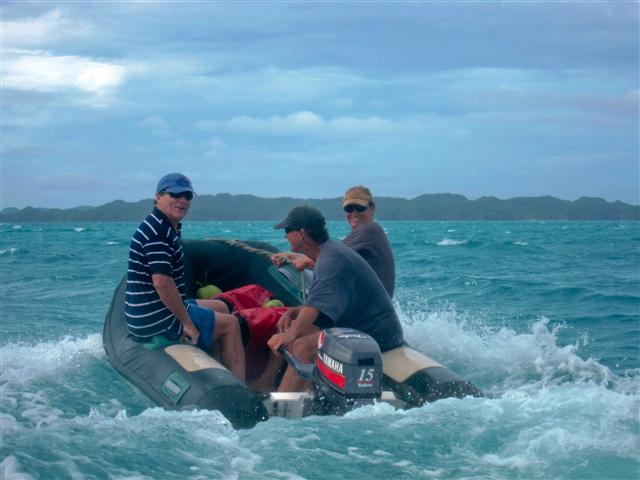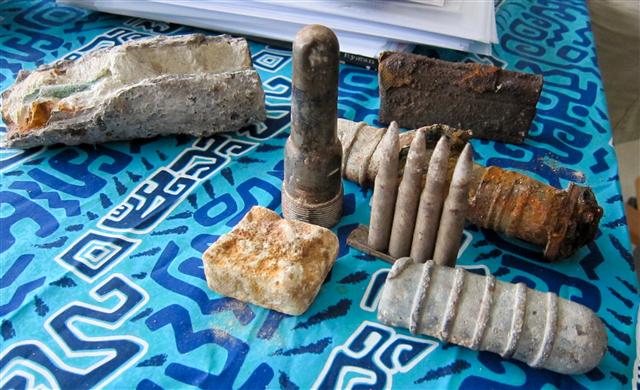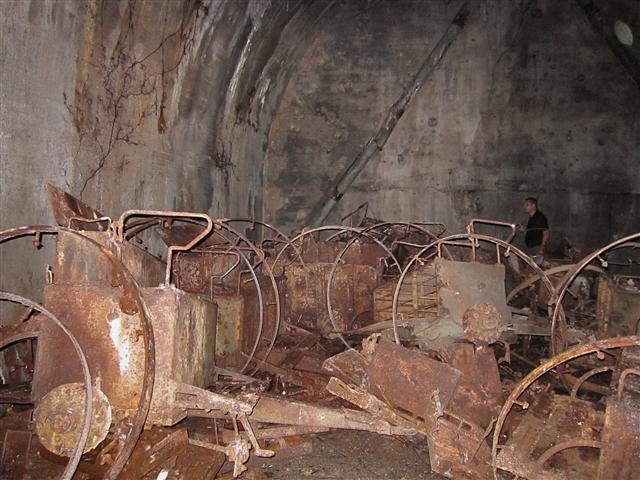
If you look closely you will see that Peleliu is in the extreme southern part of Palau. It was the site of one of the nastier WWII battles that took place between U.S. and Japanese troops. For more in depth information check out this web site: http://en.wikipedia.org/wiki/Peleliu
Doug and I visited Peleliu on two different occasions. The first trip was only a day trip and we reached Peleliu by a seven mile dinghy ride from our anchorage in the southern Rock Islands, a set of three islands locally called Two Dogs. (It seems this little group of islands was once were they kept prisoners of war and when it was vacated they left behind two dogs.)


As we were winging it and hadn’t arranged a tour previous to our arrival we ended getting deluxe accomodations for our tour. The bed of a pick-up truck. Good thing we are flexable!
Most of what we saw on this tour was easily accessable by car. There were a number of tanks, landing craft and building ruins along the many war time roads in Peleliu. Above is the ruins of the Japanese headquarters.

Inside the ruins of the Japanese headquarters there are these hanging. They are folded cranes, a thousand of them each, placed by visiting Japanese. They symbolize the wish for peace.
Here is a bit of the American’s presence.

There are a number of American and Japanese memorials around the island as well as small ones put up by relatives of soldiers.
Orange Beach was the main landing area for the American troops on September 15th, 1944. The picture on the left is what happened on September 15th, 1944. The right is what it looks like now.
There is a museum dedicated to WWII memorabilia, American and Japanese. Although not up to first world country standards as far as presentation and preservation of relics it is interesting. I also found it very interesting that they used one of the bombed out WWII buildings and converted it.

If you have been reading all of my blog you may remember that we found a WWII bomb while snorkeling. We reported it to the authorities and were told that there was currently a demolition company in Palau and that they were in the process of removing located bombs to a blast site on Peleliu and detonating them. While we were on this tour we were really lucky in running into the owners of that company, Steve, a Brit and his, as he calls her, Aussie bird, his wife, Cassandra. Really interesting and fun people. They took us out to their demolition site and gave us a quick tour.

The following picture is of a simple bomb made by the Japanese. Steve found this concrete structure, unaware it was a bomb until he noticed a small wire (the tripping device) sticking out of the end of it. He took it apart to discover a molotov cocktail type device in the middle. There was all kinds of nails and iron bits embedded in the concrete. A nasty bit of work.

The visit to the demolition site was the end of our tour and we headed back to our dinghies and to our anchorage in Two Dogs. Our next visit to Peleliu was a much longer and more comfortable stay.

This trip we planned to stay a week. Besides diving Peleliu, a much more in-depth tour of the battle sites was planned with for our new friends Steve and Cassandra. After settling in our first stop was their office where they showed us a few bits of ordnance that they had picked up.

Steve reeled off the minutia of ordnance, mortars, bombs, etc. and I must admit that it all went over my head.
Our next stop was One Thousand Man cave. Don’t know why the name. One of its uses was as a hospital.

Amazingly there is still a lot of Japanese relics left in the caves.
Our next stop was a underground (actually dug into the limestone caves and concrete reinforced) Japanese ammo dump. I belive these are all ammo carts.

We really wanted to see, and Steve really wanted to show us, Bloody Nose Ridge. The jungle has reclaimed all of Peleliu’s war sites so this was a bit of a jungle trek. Bloody Nose Ridge is where the US troops really took a beating, thus its name. Imagine a jungle just riddled with limestone caves full of Japanese soldiers. The valley transversing this area was nicknamed Death Valley. Steve is currently working in some of the caves here de-mining. He just finished up removing grenades and land mines from two different caves. After the US troops took over their policy was to just bulldoze and obliterate the entrances of the caves. There are still an awful lot of caves still blocked off like this. The Palauan government is reluctant to open them up for various reasons. As we walked along the ridge and down into the valley we found all sorts of war relics half buried in the jungle floor.
This watch is still sitting on a rock at the site where the remaining Japanese officers committed Seppuku, ritual suicide, when they realized the battle was lost.

On Bloody Nose Ridge Steve took us into one last cave. There was the remains of a rifle outside and the remains of a human inside.
Two more stops for todays tour. One was at a Japanse shrine where we did a group picture.

This last stop was at the highest spot on Peleliu and is, I believe, dedicated by the U.S. Navy. It’s quite a beautiful spot with a breathtaking view.

We all went back to our boats totally exhausted, and very subdued. It has been quite a day. But, the tour wasn’t over. The next day Steve stopped by the boats and took us off to a few more memorable sites. The first was a Japanese bomb shelter. It was amazingly intact, which I guess is a good thing for a bomb shelter that probably did get bombed.
A shorter tour, but just as impressive. The next day was a dive day and guess what we dove? Bombs. Steve and Cassandra needed to get some data on some bombs in the South Dock entrance so that was the dive for the day.

That ended our tour of Peleliu. The rest of our stay was spent exploring the underwater world around the island. Quite an adventure. But, back to Koror in a few days and the internet to get this all posted for all my friends out there.
A parting shot:



























WOW!
that’s all I can say…WOW!
Love Brenda
hi, my name is john. i’ve read alot about WW2. If you want an excellent narrative of the battle of peleliu, read the book, THE OLD BREED, by eugene sledge. I’ve read it about 15 times, never ceases to amaze me what all those men went through. would love to visit there and iwo. nice pic’s, thank you
Fantastic blog, and what a place to visit i have always been intersted in WW2 and the American / Japanese conflict in the islands. Would love to go there, and to Truk lagoon. Excelent story and sorry to see you are going back to land. Best of luck to you both.
Phil